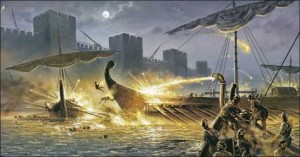How did the once mighty Byzantine Navy decline?
 Reader Jeroen asked what happened to the once mighty Byzantine navy that forced them to become so reliant on Genoese or Venetian sea power?
Reader Jeroen asked what happened to the once mighty Byzantine navy that forced them to become so reliant on Genoese or Venetian sea power?
The Byzantine navy was in a way a victim of its own success- coupled with a complete lack of vision. By the end of the Macedonian dynasty, it was the preeminent force in the eastern Mediterranean. Major seaborne invasions were carried out against targets as far away as Sicily, and Sardinia, and the traditional naval powers of the Caliphate and the Russians were a receding threat. The last serious Arab attack had come in 1035 and the last Russian one a decade later, and they both had been beaten back with ease. There seemed no reason to pay for a huge navy with no one to fight, so Constantine IX (1042-55) had the fleet broken up into smaller units. These detachments spent most of their time chasing after pirates, and quickly faded from the imperial attention. Neglect and incompetence did the rest and by the end of the 11th century the fleet was in a deplorable position. Other navies sprang up to fill the vacuum and the aging, ill-equipped Byzantines were routinely defeated by Turkish, Italian, and even Norman ships. This humiliating state forced Alexius Comnenus (1081-1118) to sign an agreement with Venice exchanging trade concessions for naval support. To his credit he recognized the danger and did his best to build up the imperial navy with the meager resources available. By the time of his death he handed over a small but serviceable fleet to his successors, which was still strong enough to fend off the Venetians two decades later (at the steep cost of one of Enrico Dandolo’s eyes).
Alexius’ son and grandson, however, discovered that fleets are very expensive, and since they were more interested in land campaigns they transferred most of the funding to the army. The next dynasty (Angelus 1185-1204) was a good deal worse, dropping even the pretense of upkeep. They depended on trade concessions with Sicily, Venice, and Genoa to keep their coasts secure, and concentrated on having a good time. One particularly pathetic emperor (Alexius III Angelus) even allowed one of his generals to sell off the warships for personal profit, virtually abolishing the navy. By the time of the 4th Crusade there were only 20 ships left, 3 of which were seaworthy. The other 17 were loaded down with Greek Fire and pushed in the direction of the Crusader’s navy. Basil II must have been spinning in his grave.